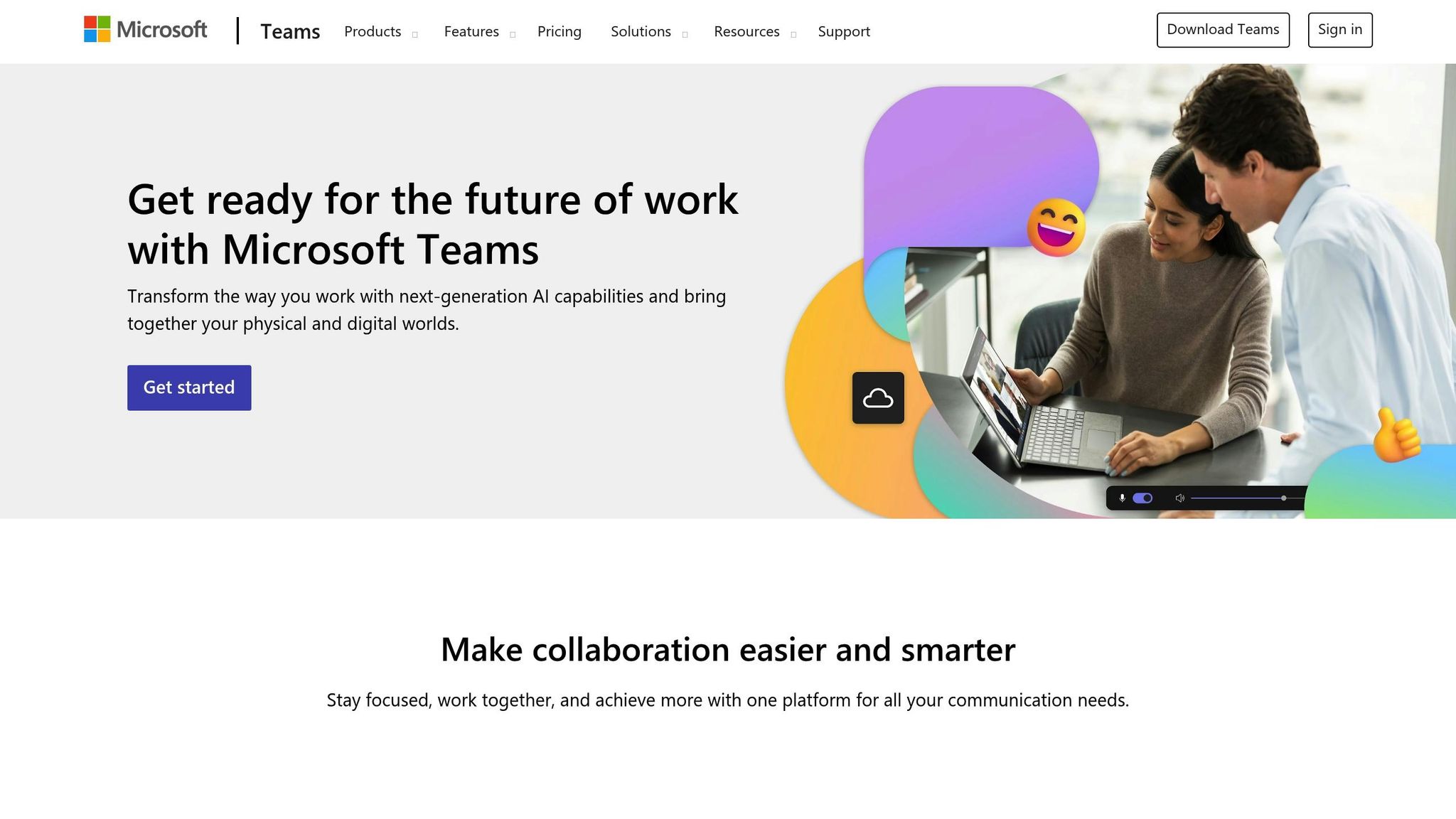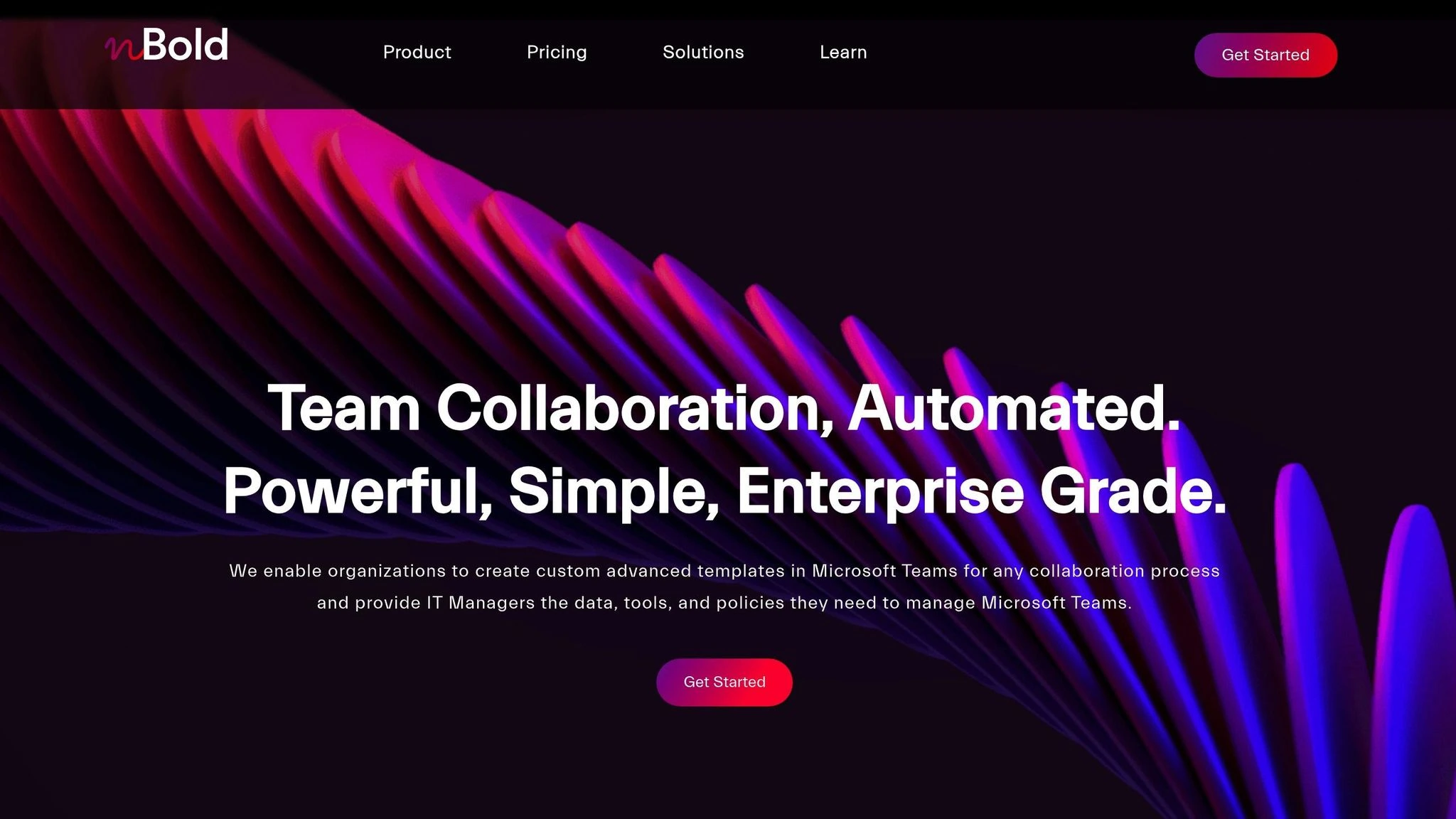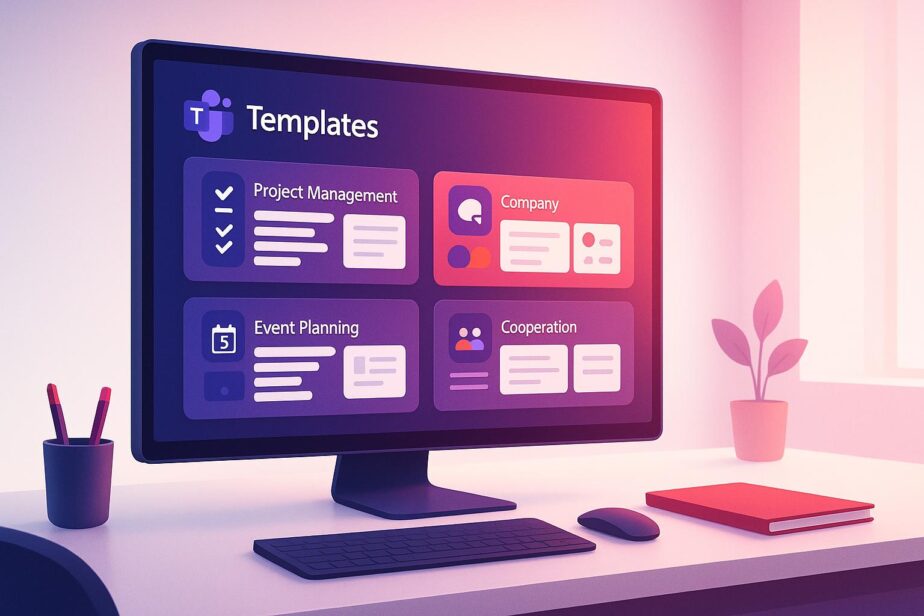Want to save time and improve teamwork in Microsoft Teams? Customizing templates is the answer. With pre-configured channels, workflows, and apps, Teams templates simplify collaboration. Here’s what you’ll learn in this guide:
- Why Custom Templates Matter: Standardize processes, save setup time, and ensure compliance.
- How to Customize: Set up templates in the Admin Center, build channel structures, and integrate Microsoft 365 apps like SharePoint and Planner.
- Advanced Features: Use custom fields, branding, and logic rules for automation.
- Security Tips: Apply data protection labels, access controls, and retention settings.
- Automation Tools: Leverage APIs, Power Automate, and tools like nBold for seamless management.
Key takeaway: Tailoring templates boosts productivity, organizes workflows, and strengthens security. Let’s dive into the details.
Template Customization Basics
Setting Up Templates in Admin Center
Head to the Microsoft Teams Admin Center to create standardized templates tailored to your organization. Set up naming conventions, approval workflows, and organize templates by categories like departments or projects. This ensures consistency and helps avoid unapproved team creation. Once templates are ready, focus on designing a channel structure that supports efficient team communication.
Building Channel Structure
A well-thought-out channel structure can make team communication smoother. Here’s a quick guide to common channel types and their uses:
| Channel Type | Purpose | Best Practice |
|---|---|---|
| General | Team-wide announcements | Use for announcements only |
| Project Management | Task coordination | Add Planner for task tracking |
| Resources | File sharing | Link to SharePoint libraries |
| Department-specific | Specialized discussions | Adjust privacy settings as needed |
Your channel setup should mirror your organization’s workflow, keeping work streams distinct and easy to navigate. This way, teams can find information and resources without wasting time.
Adding Microsoft 365 Apps
Bringing Microsoft 365 apps into Teams helps centralize tools and improve productivity. Here are a few essential integrations:
-
SharePoint Integration
Automatically create document libraries and manage files directly within team channels. This keeps file organization uniform across all teams. -
Planner Integration
Add Planner to your templates to give teams pre-set task boards and bucket structures. This allows projects to get started immediately without extra setup. -
Microsoft Lists
Use Microsoft Lists to help teams track data and manage workflows. Predefined list templates can be deployed alongside new team creation for seamless functionality.
How to create a custom Team template in Microsoft Teams

Advanced Template Settings
Take your Microsoft Teams templates to the next level by fine-tuning them for better performance and consistency.
Setting Up Custom Fields
Custom fields help capture essential metadata in Microsoft Teams templates. They make team creation smoother and improve searchability by standardizing formats for things like project codes, department IDs, or budget categories. Using consistent field formats ensures your templates align with your organization’s naming standards while simplifying reporting processes.
Once you’ve set up custom fields, the next step is adding your company’s branding to round out the template.
Company Design Elements
Incorporating your brand into Microsoft Teams templates creates a unified and professional workspace. Here are some key design elements to include:
| Design Element | Purpose | Implementation Tips |
|---|---|---|
| Company Logo | Brand recognition | Add it to the header; ensure the aspect ratio is preserved. |
| Color Scheme | Visual consistency | Use your brand’s colors for headers and accents. |
| Welcome Message | Team orientation | Add a mission statement and list key contacts. |
| Banner Images | Visual engagement | Optimize images for display within the Teams interface. |
With branding complete, you can use automated logic rules to streamline team workflows.
Template Logic Rules
Template logic rules bring automation and efficiency to your templates. They can:
- Conditional Channel Creation: Automatically add or remove channels based on the team’s purpose.
- Resource Assignment: Assign specific tools or apps depending on the type of team.
- Access Control: Set permissions and privacy levels based on template settings.
For even more efficiency, integrate tools like SharePoint, Power Automate, or third-party apps to organize files and automate workflow notifications.
"nBold is a collaboration tool designed to enhance teamwork in Microsoft Teams by providing ready-to-use templates, automated workflows, and content sharing capabilities. It helps businesses scale collaboration while maintaining control and consistency."
Template Security and Compliance
Creating efficient templates is only part of the equation – securing your Teams environment is just as important. Properly secured Teams templates safeguard data and encourage effective collaboration.
Data Protection Labels
Data protection labels let you apply security settings based on how sensitive the content is.
| Sensitivity Level | Protection Features | Example |
|---|---|---|
| Highly Confidential | Encryption, restricted sharing, watermarks | Financial data, HR records |
| Confidential | Limited sharing, download restrictions | Internal projects, strategic plans |
| Internal | Organization-wide access, external sharing blocked | Department communications |
| Public | Basic controls, monitored sharing | Marketing materials, public announcements |
Once data controls are in place, it’s essential to establish clear access rules to further secure your templates.
Access Control Rules
Use access rules to manage who can view or modify templates:
-
Membership Controls
Automate access by setting rules like:- Restricting access based on department
- Assigning permissions by role
- Requiring approvals for external guest access
-
Template Audience Targeting
Limit template visibility to specific roles to prevent unauthorized use.
By restricting access, you can better manage template usage and ensure compliance.
Template Retention Settings
Retention settings help you manage template lifecycles effectively:
- Automate Content Archival: Automatically archive inactive teams after a set time.
- Define Data Preservation: Create retention policies tailored to different content types.
- Monitor Usage Patterns: Analyze how templates are used to refine security measures.
These retention practices help secure outdated information and ensure compliance with data protection standards. Implementing these measures builds a strong, secure foundation for your Teams templates while meeting organizational compliance needs.
sbb-itb-8be0fd2
Template Automation Tools
Take your Teams templates to the next level by automating their deployment for consistent and hands-free management. Automation tools simplify template handling and reduce manual effort.
API Template Creation
Microsoft Teams REST APIs allow you to automate the deployment and updates of templates across your organization.
Here’s a breakdown of the components needed for API-based automation:
| Component | Purpose | Implementation |
|---|---|---|
| REST Endpoints | Create and modify templates | Define the structure and settings |
| Authentication | Secure API access | Use Microsoft Identity Platform |
| Payload Structure | Configure templates | Use JSON format for template definitions |
Power Platform Integration
By integrating with Power Platform, you can enhance automation using low-code tools. Power Automate connects Microsoft Teams with other business applications, making workflows more efficient and dynamic.
Key features include:
- Workflow Triggers: Automatically create teams based on business events.
- Dynamic Content: Fill templates with data from connected systems.
- Approval Flows: Add governance through automated approvals.
Pair these workflows with performance tracking to get the most out of your templates.
Template Usage Tracking
Automation isn’t just about deployment – it’s also about tracking and improving performance. Monitor how templates are used to gain insights such as:
- Adoption Rates: See how often templates are utilized.
- Deployment Trends: Understand when and how templates are being applied.
- Performance Metrics: Measure load times and success rates.
nBold integrates with Microsoft Teams to offer no-code template creation, simplified deployment, and seamless connections with third-party apps. This creates a unified collaboration environment.
nBold Template Tools

nBold simplifies Teams template customization with a range of powerful features.
nBold Core Features
nBold’s no-code template builder provides extensive customization options. Here’s a breakdown of its main features:
| Feature | Description | Business Impact |
|---|---|---|
| Channel Structure | Define and automate channel creation | Keeps team organization consistent |
| File Templates | Upload and manage document templates | Ensures standardized documentation |
| Task Management | Create Planner boards and task templates | Simplifies workflows |
| CRM Integration | Connect directly to Salesforce and HubSpot | Improves business processes |
It works seamlessly with Microsoft 365 apps like SharePoint and Power Automate, offering a unified space for collaboration.
Benefits of Using nBold Templates
Teams using nBold often see noticeable improvements in their Microsoft Teams environment. The platform’s governance tools help avoid data loss and control unnecessary team creation, all while keeping security intact. Some key advantages include:
- Organized collaboration processes
- Increased team productivity
- Consistent project management
- Simplified workflow automation
- Better data governance
How to Set Up nBold
Start by exploring nBold’s features through a free trial.
2. Template Configuration
Set up the following key elements:
- Channel structures
- File and folder hierarchies
- Planner boards and tasks
- Microsoft Lists integration
3. Governance Policies
Put essential rules in place:
- Naming conventions
- Team creation approval workflows
- Membership and ownership guidelines
- Audience restrictions for templates
nBold offers two pricing options: Pro at $3 per user/month and CRM at $15 per user/month, with discounts available for larger teams. The Pro plan includes core template-building and governance tools, while the CRM plan adds integrations with popular customer relationship management platforms.
Check the next section for the final steps to implementation.
Conclusion
Key Takeaways
Customizing Microsoft Teams templates can transform how businesses collaborate and manage their digital workspace. Benefits include organized workflows, stronger security measures, and more efficient processes that lead to consistent results.
For instance, companies like WÖLFEL have seen measurable productivity improvements by tailoring Microsoft Teams to their needs, showcasing the real potential of template customization.
Here are some of the standout features and their business impacts:
| Feature | Business Impact |
|---|---|
| Channel Structure | Keeps team organization and communication on track |
| File Templates | Promotes consistent document usage across projects |
| Security Controls | Protects data and limits unauthorized access |
| Workflow Automation | Cuts down on repetitive tasks and boosts productivity |
| CRM Integration | Simplifies customer relationship management processes |
These elements can serve as a foundation for setting up a more efficient digital workspace.
Steps to Implement
To make the most of these benefits, follow these steps:
-
Template Design
- Plan out channel structures.
- Develop standardized file templates.
- Build task management frameworks.
- Create clear naming conventions.
-
Governance Setup
- Set up security measures and access controls.
- Design approval workflows.
- Identify who will use each template.
-
Integration Configuration
- Link key business applications.
- Establish automation workflows.
- Connect CRM tools.
- Configure Power Platform features.
Companies like AMPCO have shown that using templates effectively can bring structure and consistency to teamwork, making collaboration smoother throughout the organization.
FAQs
How can I make sure my Microsoft Teams templates meet my organization’s security and compliance requirements?
To ensure your Microsoft Teams templates align with your organization’s security and compliance standards, you can use tools like nBold to create custom templates that incorporate your policies and procedures. This helps maintain secure collaboration while minimizing IT overhead and reducing risks like data loss or duplication.
With nBold, you can enforce important safeguards such as naming conventions, approval workflows for team creation, and limiting template access to specific audiences. These features ensure that your templates are consistently secure and compliant across your organization.
How do Microsoft 365 apps like SharePoint and Planner improve productivity when integrated into Teams templates?
Integrating Microsoft 365 apps such as SharePoint and Planner into Teams templates helps streamline workflows and centralize important resources. By embedding these tools directly into your templates, you can ensure that teams have immediate access to shared files, structured task management, and collaboration tools from the moment a team is created.
This integration also promotes consistency by allowing you to predefine channel structures, file templates, and task boards. Teams can follow a standardized framework for recurring processes, saving time and boosting efficiency across projects. Overall, it simplifies team setup and ensures everyone is aligned from the start.
How do automation tools like Power Automate and APIs simplify managing and deploying Microsoft Teams templates?
Automation tools such as Power Automate and APIs make it easier to manage and deploy Microsoft Teams templates by streamlining repetitive tasks and optimizing workflows. These tools allow you to automate the creation of team templates, channels, file structures, and more, saving time and reducing manual effort.
By integrating with Power Automate and REST APIs, you can also connect Microsoft Teams to third-party applications, enabling seamless collaboration and enhancing productivity. This ensures that your team templates are not only customized to your needs but also efficiently deployed across your organization.
